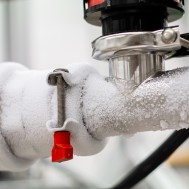As the temperature drops, most rubber materials begin to reach their glass transition temperature, hardening the rubber. At low temperatures, we also start to see increased resistance to deformation. This deformation can cause a seal gland to become less effective — a real problem for low pressure applications.
The Process
New applications are pushing the limits of low temperature performance in standard rubber compounds. In most cases, formulation changes must be made to meet these new criteria. That’s why the team at Apple Rubber decided to take a closer look at three common polymers, Nitrile Rubber (NBR), Silicone (SL), and Fluorocarbon (FKM), to find ways to improve their performance at low temperatures.
Nitrile Rubber (NBR)
In a rail car’s air braking system, a customer’s industry requirements unexpectedly changed from -30°C to -50°C. NBR o-rings were used in this application due to the presence of petroleum based lubricants. However, the compound being used contained a 33% acrylonitrile content (ACN). For NBR compounds, the higher the ACN, the lower the volume swell in oil and the higher the glass transition temperature.
To meet lower temperature performance, our compounders needed to change the ACN. To improve low temperature performance, we opted to use a base polymer of 23% ACN. ACN can range from 19% to 50%. To compensate for higher volume swell, we changed out the extraction resistant plasticizer. This allowed our customer’s air valve to operate at a lower temperature while maintaining the same lubrication — all while leaving the polymer price unaffected.
Silicone (SL)
A (possibly famous) Apple Rubber aerospace customer was using a standard dimethyl silicone rated for -65°C. During performance testing, our customer noticed that the silicone’s flex strength was still too high at -65°C, and they were unable to find a workable alternative. This was going to force our customer to replace their current motor in favor of one with a higher force capability.
Our recommendation was to use a phenyl-based silicone. These silicones are rated down to -104°C. Typically, this polymer can be interchanged in compression molded formulations, but doing so would double the cost of the rubber. Applying the phenyl-based silicone resulted in a lower torsional stiffness at -65°C and allowed the device to operate at lower forces.
Fluorocarbon (FKM)
A customer that produces sensors for oil field pipelines came to us for help. Since they primarily supply to southern pipelines, low temperature performance was not a big concern for their sensor applications. However, when our customer wanted to increase their market share, they decided that they needed to improve the lower temperature performance of their sensor. Their sensor application required a bisphenol cured standard FKM o-ring. These compounds are typically rated to -15°C for static applications. Moving to a low-temperature performance FKM base would change the polymer and cure system of the formulation. This change would then rate the compound to -40°C temperature performance.
The new FKM compound would be cured with peroxide and have a slightly higher compression set. While the price of the new rubber compound would triple, the small o-ring used for this application would not require a lot of material to produce.
Key Takeaways
In some cases, a base polymer change will not meet requirements for a low temperature application, meaning that a completely different class of rubber may be needed. By closely examining a given problem, Apple Rubber engineers are able to find a solution that works well for our clients.
Enjoying Solved and Sealed?
Check out our full reports on other rubber industry challenges here!
